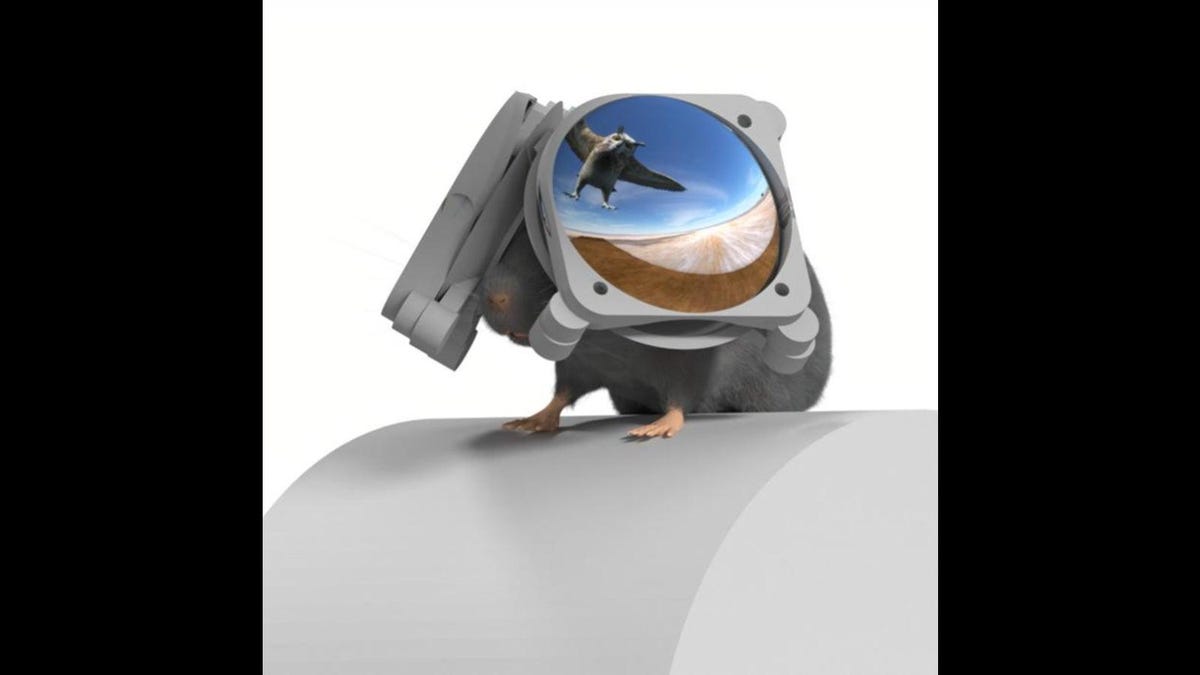Researchers at Northwestern University have crafted miniature virtual reality (VR) goggles specifically designed for mice. Dubbed the Miniature Rodent Stereo Illumination VR (iMRSIV), these goggles provide a level of immersion previously unseen in mouse experiments.

Also Read: Rare White Leucistic Alligator Born at Florida Gator Park
Unlike traditional setups involving flat displays, the iMRSIV system covers the mouse’s entire field of view, offering researchers a glimpse into the neural circuits and behaviors of these small mammals.
The iMRSIV system, a brainchild of Northwestern University researchers, seeks to overcome the limitations of conventional VR setups for mice.
Instead of fixing the goggles to the mouse’s head like a typical human VR headset, the iMRSIV goggles are positioned at the front of a treadmill, surrounding the mouse as it runs in place.
“We designed and built a custom holder for the goggles. The whole optical display the screens and the lenses go all the way around the mouse,” explains John Issa, co-first author of the study.
This design allows for a 180-degree field of view for each eye, fully immersing the mouse and eliminating distractions from the surrounding environment.
The system employs custom lenses and miniature organic light-emitting diode (OLED) displays, providing a 3D visual experience tailored for mice.
The iMRSIV’s design opens up avenues for studying neural circuitry and behavior in more natural scenarios.
Scientists have utilized rudimentary VR setups for mice, typically involving large screens. These setups, however, had limitations, including the lack of depth perception and the inability to create truly immersive environments.
Also Read: Google Launches Gemini, the Most Advanced AI Model
Daniel Dombeck, the senior author of the study, notes, “For humans, this is like watching a TV in your living room. You still see your couch and your walls. There are cues around you telling you that you aren’t inside the scene.”
The iMRSIV system, with its design and 3D visual capabilities, addresses these shortcomings, offering a more authentic simulation of natural environments.
By faithfully replicating real-world scenarios, researchers can delve into the neural circuitry and behavior with precision.
One of the advancements facilitated by iMRSIV is the ability to simulate overhead threats, a scenario previously challenging to replicate.
Researchers projected expanding dark spots at the tops of the displays to mimic threats like birds swooping in for prey.
Dom Pinke, co-first author, addresses, “The top of a mouse’s field of view is very sensitive to detect predators from above, like a bird. It’s not a learned behavior; it’s an imprinted behavior. It’s wired inside the mouse’s brain.”
The mice’s responses to these simulated threats were observed in both their outward physical reactions and neural activity.
Also Read: Wikipedia’s Top 25 Most Viewed Articles of 2023
The researchers noted that the mice quickly adapted to the new VR environment, showcasing behaviors wired into their brains as a response to threats.
This newfound ability to study innate behaviors in response to specific stimuli provides valuable insights into the neural mechanisms governing these reactions.
The researchers found that mice using the iMRSIV system exhibited quicker engagement with the virtual environment.
The elimination of distracting elements and the creation of a more immersive experience played a role in the mice’s interaction with the VR scenarios.
Daniel Dombeck addresses the importance of the immersion, stating, “We’ve had a lot of success with this VR system, but it’s possible the animals aren’t as immersed as they would be in a real environment.
It takes a lot of training just to get the mice to pay attention to the screens and ignore the lab around them.”
The relatively low cost and reduced laboratory setup requirements of the iMRSIV system could democratize neurobiology research, making it more accessible to a range of researchers and institutions.
The development of iMRSIV represents a shift in the study of mice’s neural circuitry and behavior. Its design, enhanced immersion, and ability to simulate realistic scenarios mark a new era in neuroscience research.
As scientists unlock the potential of iMRSIV, we can anticipate a cascade of discoveries that will deepen our understanding of the brain’s complexities.
Also Read: Meta Shuts 4,800 Fake Accounts Over Alleged China-based Influence Campaign





















